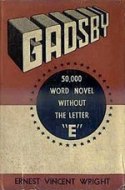 Talk about a writing challenge: I’d say constructing a 300-page novel without the most commonly used letter in the English language would definitely rank right up there. For two relatively obscure novelists, Georges Perec (1936-1982) and Ernest Vincent Wright (1872-1939), it was the ultimate word game, with the added demands of forging a plot and a story as well.
Talk about a writing challenge: I’d say constructing a 300-page novel without the most commonly used letter in the English language would definitely rank right up there. For two relatively obscure novelists, Georges Perec (1936-1982) and Ernest Vincent Wright (1872-1939), it was the ultimate word game, with the added demands of forging a plot and a story as well.
Perec and Wright were both masters of the lipogram, an aspect of language known as “constrained” writing, where the use of a letter – often “e” — or a series of letters, is not allowed. (As if writing weren’t hard work enough.) The self-imposed rules force a limiting of literary possibilities, and conjures the metaphorical example of a runner attempting a marathon without the use of a leg.
Perec’s book, La Disparition, originally published in French, was later released in English with the title, A Void, and its translation also held to the lipogramic standard. In a postscript to the English version, Perec remembers his mind traversing “down so many intriguing linguistic highways and byways.” Rather than restrictive, he found the trip a creatively liberating experience.
Ernest Vincent Wright preceded Perec (whose Void was published in 1969), with a novel called Gadsby ( yes, that’s with a “d”) from 1939, a 50,000-word tome that he wrote in about six months — with the letter “e” tied down on his typewriter. (A feat that would have taken most of us six years.) Now viewed as an oddity, the book is rarely found these days, and the few copies still floating around can be worth in the thousands.
Gadsby is more than just a curio piece, however, and actually rather remarkable. (The complete book is archived for the public  here.) In the introduction, Wright makes an intriguing point about the difficulties of attempting a story without the use of that invaluable vowel: “The greatest of these is met in the past tense of verbs, all of which end with ‘_ed,’” he wrote. “Therefore substitutes must be found; and they are very few,” he emphasized.
here.) In the introduction, Wright makes an intriguing point about the difficulties of attempting a story without the use of that invaluable vowel: “The greatest of these is met in the past tense of verbs, all of which end with ‘_ed,’” he wrote. “Therefore substitutes must be found; and they are very few,” he emphasized.
And in a quaint nod to the innocence – or shall we say provincialism – of the times:
“The numerals also cause plenty of trouble, for none between six and thirty are available. When introducing young ladies into the story, this is a real barrier; for what young woman wants to have it known that she is over thirty?”
A quick perusal brings home Gadsby‘s sleight-of-hand. If you weren’t aware of their absence, you’d never notice that a “whole army of little E’s all eagerly expected to be called upon,” as Wright called them, were missing in action.
I’ll finish by stating my distinct fascination with this highly idiosyncratic form of linguistic wordplay. (Look, no E’s!)
